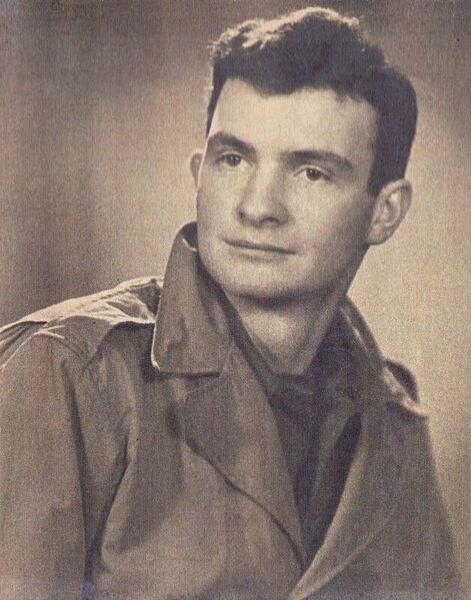James Louis Steg

T/SGT in 603rd Engineer Camouflage Bn : Co B, 2nd Platoon
ASN#12166795
Born 1922 in VA, Died 2001
Artist
County of residence at enlistment: Monroe County, NY
Other residence(s): Ithaca, NY; New Orleans, LA
United States Army, European Theatre of Operations
Occupation before the war: commercial artists
College education after the war: Rochester Institute of Technology; Univ. of Iowa
Jim Steg was born on February 6, 1922 in Alexandria, VA. He was the middle child of five, and grew up on a farm in Chili, NY, outside Rochester.
He showed a natural artistic talent from an early age. While still in high school, he traveled to Chicago to attend a workshop at the Art Institute; that experience constituted his first formal artistic training.
After graduating from high school, he attended Rochester Institute of Technology. When he registered for the draft, on June 30, 1942, he stated that he was working for his father—on the farm, no doubt. When he enlisted, on September 21, 1942 (or 1943—data not clear), he said that he was a commercial artist.
During his tenure in the Ghost Army, he was a prolific artist, producing graphite and watercolor portraits of civilians, soldiers, and refugees in Europe.
Jim Steg and a number of other artists in the unit showed their work at an attic gallery in their barracks in Briey, France, in the last months of the war (in between trips to the front). Jim appears to have been responsible for designing the notices for the exhibitions. (His website contains selected images from the 78 charcoal and watercolor drawings that he created during the war.)
He was released from the Army on October 21, 1945 with the rank of T/SGT. Shortly afterwards, he had his first solo show at the Weyhe Gallery in New York City where he exhibited his wartime portraits.
Then he enrolled at the University of Iowa, where he finished his bachelor's degree, and earned an MFA in printmaking. It was there that he began to incorporate more abstract and cubist influences into his work, which had previously been figurative (as can be seen in his wartime work). After graduation, he worked for a year or two as an instructor in printmaking at Cornell University's College of Architecture, until he was offered a tenure track faculty position at Tulane University's Newcomb College. He was an assistant professor there by 1952, and promoted to associate professor in 1957.
Somewhere along the way, Jim married Mary O'Brien, and they went on to have three children together: Christopher, Adam, and Lucinda.
Jim made an artistic name for himself early on. He received an award at the Philadelphia Print Club annual exhibition of American printmaking in 1947, he was invited to exhibit at the International Gravure Exhibition in Paris in 1949, and by 1952 had shown his work in all the major national print exhibitions.
According to the catalog for a 2017 show of his work, he used "almost every known printmaking method of his time, and even pioneered several of his own." He experimented with etching, engraving, woodblock printing, serigraphy, lithography, and collage intaglio. He was one of the first American printmakers to apply commercial photo transfer techniques of magazine and newspaper production to the fine arts, particularly etchings and silkscreens. He also painted and carved wooden sculptures.
Beginning in the early 1960s, he was represented by the NYC gallery Associated American Artists.
In the early 1970s he began to explore the human figure in a new way by using his own body as an implement, often rolling his face across a prepared plate.
By 1971, he had been named chair of the printmaking department at Newcomb. But along with his teaching, and department management, he also produced much independent work. Today his prints are part of the collections at the Brooklyn, New Orleans, Philadelphia, and Seattle art museums, at the Metropolitan Museum of Art, the Museum of Modern Art, the Library of Congress, and the National Gallery. A total of 60 institutions around the world house his art as part of their permanent collections. In 1978, his work was exhibited at the New Orleans Museum of Art in an exhibit entitled "Thirty Years of J.L. Steg: 1948-1978." He retired from Tulane-Newcomb in 1990.
He died on February 19, 2001 in New Orleans, and is buried at the Garden of Memories in Metairie, LA. He was survived by his second wife, Frances Swigart Steg, who had been a student of his at Newcomb, but did not marry him until many years later.
Five of his watercolors were included in the Ghost Army Exhibit at the World War II Museum in New Orleans in 2020.
Sources:
1940 census
https://www.ancestry.com/discoveryui-content/view/8782490:2442?tid=171184406&pid=262228207612
1942 draft card
1942 enlistment record
1947 article in the Philadelphia Inquirer re an art exhibit of his
https://www.newspapers.com/image/172618041/?terms=james%20l%20steg&match=1
1950 article in the The Ithaca Journal (NY) re his teaching at Cornell
https://www.newspapers.com/image/257375226/?terms=james%20l%20steg&match=1
1952 article in the Monroe News-Star (LA); contains biographical details
https://www.newspapers.com/image/86250902/?terms=james%20l%20steg&match=1
1957 article in the Monroe News-Star (LA) re an art prize he won
https://www.newspapers.com/image/74424470/?terms=james%20l%20steg&match=1
1957 article in the Democrat and Chronicle (Rochester NY) re his promotion and education
https://www.newspapers.com/image/135566282/?terms=james%20l%20steg&match=1
1963 article in Monroe Morning World (LA) re an art prize he won
https://www.newspapers.com/image/83005796/?terms=james%20l%20steg&match=1
1964 article in the Philadelphia Inquirer re an art show of his
https://www.newspapers.com/image/180553757/?terms=james%20l%20steg&match=1
1971 article in the Holland Evening Sentinel (MI) re an art show of his; contains biographical details
https://www.newspapers.com/image/11401091/?terms=james%20l%20steg&match=1
2001 VA death record
2001 US Veterans' Gravesites
2001 Obituary in Times-Picayune (New Orleans, LA)
2001 Find a Grave record
https://www.findagrave.com/memorial/229651548/james-louis-steg
2017 catalog for a showing of his work at the New Orleans Museum of Art; notes by Russell Lord
https://issuu.com/mcdegnan/docs/19-0117_jim_steg_booklet-lowres
Wikipedia biography
https://en.wikipedia.org/wiki/Jim_Steg
James Steg website